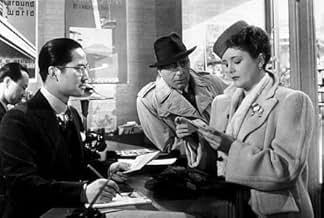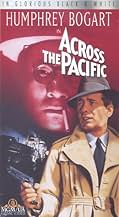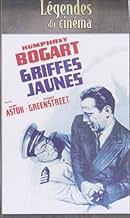VALUTAZIONE IMDb
6,8/10
5623
LA TUA VALUTAZIONE
Aggiungi una trama nella tua linguaIn December 1941, ex-army captain Rick Leland boards a Japanese ship heading to Asia via the Panama Canal where his Japanese hosts show interest in the American defense plans for the canal z... Leggi tuttoIn December 1941, ex-army captain Rick Leland boards a Japanese ship heading to Asia via the Panama Canal where his Japanese hosts show interest in the American defense plans for the canal zone.In December 1941, ex-army captain Rick Leland boards a Japanese ship heading to Asia via the Panama Canal where his Japanese hosts show interest in the American defense plans for the canal zone.
- Regia
- Sceneggiatura
- Star
- Premi
- 1 vittoria e 1 candidatura in totale
Victor Sen Yung
- Joe Totsuiko
- (as Sen Young)
Lee Tong Foo
- Sam Wing On
- (as Lee Tung Foo)
Recensioni in evidenza
"Across the Pacific" is a fairly well done spy movie that takes place in the last days before America's entry into World War II. Rick Leland (Humphrey Bogart) is cashiered from the U.S. Army for stealing funds. The events that follow involve a love interest (Mary Astor) and an enemy agent (Sydney Greenstreet) and a trip on a passenger ship from New York to the Panama Canal. Humphrey Bogart as an American spy is convincing in a role that might have been played by Sean Connery 20 years later.
The subplot of a Japanese plot to torpedo the Panama Canal and put it out of action was a case of truth being stranger than fiction with the recent revelation of Japanese submarines which carried planes designed to knock the canal out, but which were never used. "Across the Pacific" has humor, action and romance and is one of Bogart's lesser known but very good movies.
The subplot of a Japanese plot to torpedo the Panama Canal and put it out of action was a case of truth being stranger than fiction with the recent revelation of Japanese submarines which carried planes designed to knock the canal out, but which were never used. "Across the Pacific" has humor, action and romance and is one of Bogart's lesser known but very good movies.
There are films that are so connected to their times, when taken out of context there's no rhyme, no reason for portrayals, but factor in the great betrayals, lets you accept the extremes, of paradigms. As Rick Leland is disgraced and then ejected, from a role that he would like to have perfected, leaves him in a tricky place, after losing all his face, and he's become quite disengaged and disaffected. On a boat he gets to meet curious souls, who have ambitions to dispose and take controls, as the layers are peeled back, looks like there might be an attack, by the folks who like to eat food out of bowls.
Of its time.
Of its time.
Films made around this time always have an interesting behind the scenes story, and "Across the Pacific" from 1942 is no different.
Rick Leland (Humphrey Bogart) is court-marshaled and booted out of the service; he then heads for Canada and attempts to enlist, but the Canadians know who he is and say they can't use him.
Leland then leaves on a Japanese ship for the Orient, making no bones about the fact that his talents are for sale! He meets an attractive woman, Alberta Marlow (Mary Astor) and one Dr. Lorenz (Sidney Greenstreet). Lorenz loves the Japanese and its people, and speaks the language very well.
You'll probably guess most of this.
This is a Maltese Falcon template, with the exception of the absence of Peter Lorre. John Huston directed, but when we entered the war, he left to do documentary films for the government. Vincent Sherman started the film at a difficult moment in the action, and he asked Huston how a particular situation would be resolved. Huston said, "That's your problem!" and left.
Originally this film had to do with stopping an attack on Pearl Harbor, but we all know what happened there, so the plot was changed to the Panama Canal.
I liked this film - there is a lot of light repartee between Bogart and Astor, which is fun and makes the film less intense than it might have been. They worked very well together. And you really can't beat Sidney Greenstreet when it comes to being slimy.
The majority of the Japanese in the movie were actually Chinese since most of the Japanese were interred, a black mark not often discussed, which is odd.
Some exciting action and solid work by all the cast.
Rick Leland (Humphrey Bogart) is court-marshaled and booted out of the service; he then heads for Canada and attempts to enlist, but the Canadians know who he is and say they can't use him.
Leland then leaves on a Japanese ship for the Orient, making no bones about the fact that his talents are for sale! He meets an attractive woman, Alberta Marlow (Mary Astor) and one Dr. Lorenz (Sidney Greenstreet). Lorenz loves the Japanese and its people, and speaks the language very well.
You'll probably guess most of this.
This is a Maltese Falcon template, with the exception of the absence of Peter Lorre. John Huston directed, but when we entered the war, he left to do documentary films for the government. Vincent Sherman started the film at a difficult moment in the action, and he asked Huston how a particular situation would be resolved. Huston said, "That's your problem!" and left.
Originally this film had to do with stopping an attack on Pearl Harbor, but we all know what happened there, so the plot was changed to the Panama Canal.
I liked this film - there is a lot of light repartee between Bogart and Astor, which is fun and makes the film less intense than it might have been. They worked very well together. And you really can't beat Sidney Greenstreet when it comes to being slimy.
The majority of the Japanese in the movie were actually Chinese since most of the Japanese were interred, a black mark not often discussed, which is odd.
Some exciting action and solid work by all the cast.
This film is okay -- watchable and even interesting -- but one can't help comparing it to "The Maltese Falcon" which appeared the previous year. Same principle actors -- Bogart, Mary Astor, Sidney Greenstreet -- no Peter Lorre fondling the handle of his cane, alas, and no gunsel -- and, for the most part, the same Director, John Huston. Huston was called up for Signal Corps duty halfway through filming and as a gag shot the scenes up to the point at which Bogart was strapped helplessly into a chair and surrounded by armed guards, a situation seemingly without the possibility of escape. Then Huston cheerfully said goodbye and walked off the set, leaving his replacement, Vincent Sherman, to try to figure out how to get Bogart free.
It may be unfair to compare "Across the Pacific" to a lucky shot like "The Maltese Falcon," but this film invites the comparison. Not just the same performers but similar lines -- "You're good, Angel, very, very good." But in Falcon the actors fit their fictional characters like enzymes accommodating themselves to a substrate. Here they are just actors playing familiar roles: the obese villain, the officer who's dishonorable discharge is faked so he can go undercover (Gary Cooper could have done as well, and in fact DID in a later movie), the innocent woman made to look bad because the enemy has imprisoned her dissolute father. The Japanese are all plain-vanilla bad guys, even the familiar young one who makes amusing wisecracks in American slang. And all the Japanese have real names like Tong, Chan, Loo, Fong, and Ahn. (To be fair, the last one is Korean, not Chinese.)
If the characters are not nearly as much fun to watch as in "The Maltese Falcon," the plot is no more than a simple war-time mystery involving secret information that the Japanese want to use to start the war by torpedoing the locks of the Panama Canal. Actually, the Japanese did develop such plans later in the war. They intended to deliver a handful of torpedo planes to the vicinity of the Canal in huge submarines, which were available. The planes were not, and the plans folded when the war ended.
In the movie, the characters move from New York to Canada, then board a Japanese steamer, back to New York, then to Panama, where they disembark. They travel from the Atlantic side of the canal to the Pacific -- but they never make it across the Pacific.
It may be unfair to compare "Across the Pacific" to a lucky shot like "The Maltese Falcon," but this film invites the comparison. Not just the same performers but similar lines -- "You're good, Angel, very, very good." But in Falcon the actors fit their fictional characters like enzymes accommodating themselves to a substrate. Here they are just actors playing familiar roles: the obese villain, the officer who's dishonorable discharge is faked so he can go undercover (Gary Cooper could have done as well, and in fact DID in a later movie), the innocent woman made to look bad because the enemy has imprisoned her dissolute father. The Japanese are all plain-vanilla bad guys, even the familiar young one who makes amusing wisecracks in American slang. And all the Japanese have real names like Tong, Chan, Loo, Fong, and Ahn. (To be fair, the last one is Korean, not Chinese.)
If the characters are not nearly as much fun to watch as in "The Maltese Falcon," the plot is no more than a simple war-time mystery involving secret information that the Japanese want to use to start the war by torpedoing the locks of the Panama Canal. Actually, the Japanese did develop such plans later in the war. They intended to deliver a handful of torpedo planes to the vicinity of the Canal in huge submarines, which were available. The planes were not, and the plans folded when the war ended.
In the movie, the characters move from New York to Canada, then board a Japanese steamer, back to New York, then to Panama, where they disembark. They travel from the Atlantic side of the canal to the Pacific -- but they never make it across the Pacific.
A good spy caper starring Humphrey Bogart as Rick Leland, a court-martialled US Army officer who finds himself in the middle of a nifty little bit of espionage work on board a Japanese freighter bound from Halifax to Yokohama via the Panama Canal just before the attack on Pearl Harbour. Surrounded by a rather suspicious group of characters, from his love interest Alberta Marlow (Mary Astor) to Dr. Lorenz (Sydney Greenstreet), Leland slowly uncovers a Japanese plot to attack the Canal Zone (presumably also on December 7) and sets himself to preventing it.
This was a good performance by Bogart, along with good performances from Astor and Greenstreet. (For those not entirely familiar with Canadian geography, by the way, the pun is that Alberta claims to be from Medicine Hat, which is a small city in Alberta - almost TOO cute!) There's a fair amount of tension throughout as we struggle along with Leland to figure out exactly what's going on, and a nice climax as Leland foils the Japanese plan (Bogey had to win!)
A couple of things I thought were worth noting, though. First of all, what's with the title? All the action in the movie takes place either on the Japanese freighter as it travels south down the ATLANTIC coast of North America or in the Panama Canal Zone (with some minor scenes in Halifax, where Leland is rejected by the Canadian Army, and in New York City, where he snoops for information.) The only Pacific connection to the movie is that the freighter was Japanese. And remember, of course, that this was made in 1942 (after Pearl Harbour.) The depiction of the Japanese isn't especially flattering (although I thought it was more a play on stereotypes than openly antagonistic), and the closing shot of the film is the wartime requisite showing off of American military strength.
All in all, though, I enjoyed this movie immensely, and would highly recommend it.
8/10
This was a good performance by Bogart, along with good performances from Astor and Greenstreet. (For those not entirely familiar with Canadian geography, by the way, the pun is that Alberta claims to be from Medicine Hat, which is a small city in Alberta - almost TOO cute!) There's a fair amount of tension throughout as we struggle along with Leland to figure out exactly what's going on, and a nice climax as Leland foils the Japanese plan (Bogey had to win!)
A couple of things I thought were worth noting, though. First of all, what's with the title? All the action in the movie takes place either on the Japanese freighter as it travels south down the ATLANTIC coast of North America or in the Panama Canal Zone (with some minor scenes in Halifax, where Leland is rejected by the Canadian Army, and in New York City, where he snoops for information.) The only Pacific connection to the movie is that the freighter was Japanese. And remember, of course, that this was made in 1942 (after Pearl Harbour.) The depiction of the Japanese isn't especially flattering (although I thought it was more a play on stereotypes than openly antagonistic), and the closing shot of the film is the wartime requisite showing off of American military strength.
All in all, though, I enjoyed this movie immensely, and would highly recommend it.
8/10
Lo sapevi?
- QuizDirector Vincent Sherman met with John Huston just before Huston left the project to join the United States Army Signal Corps to shoot documentaries for the war effort.
The two directors conferred just before they were about to shoot the scene in which Leland is trapped in the movie theatre and three assassins are trying to kill him.
"How does he get out?" Sherman asked. Huston replied, "That's your problem! I'm off to the war!"
John Huston then went off to join the war effort before the film was finished, taking the film script with him, explaining "Bogie will know how to get out." The studio's solution to the problem was to discard Huston's footage of the impossible dilemma and write a new scenario. Vincent Sherman directed the final scenes.
- BlooperThe background for the opening titles is a map of the Panama Canal. The orientation of the map and the compass is correct, but the labeling of the map is incorrect. In fact, the Atlantic end of the canal and the city of Colon are at the upper left (Northwest), and the Pacific end of the canal and Panama City are at the lower right (Southeast). The map is correctly labeled behind the closing credits.
- Citazioni
Rick Leland: [comparing his gun to Dr. Lorenz's, which he points at him] Remember: mine is bigger than yours!
- Curiosità sui creditiOpening Card:
Governor's Island
New York
- Versioni alternativeAlso available in a computer colorized version.
- ConnessioniFeatured in Frances Farmer Presents: Across the Pacific (1959)
I più visti
Accedi per valutare e creare un elenco di titoli salvati per ottenere consigli personalizzati
- How long is Across the Pacific?Powered by Alexa
Dettagli
- Data di uscita
- Paese di origine
- Lingue
- Celebre anche come
- Across the Pacific
- Luoghi delle riprese
- Azienda produttrice
- Vedi altri crediti dell’azienda su IMDbPro
- Tempo di esecuzione1 ora 37 minuti
- Colore
- Proporzioni
- 1.37 : 1
Contribuisci a questa pagina
Suggerisci una modifica o aggiungi i contenuti mancanti







































